
When it comes to writing text for your blog and social media posts, many marketers wonder, "But what's the character limit?" It's never a simple question -- sometimes, it's answered by parameters established by certain channels. And on other occasions, it's more a question of what's ideal.
For example, you probably know the character limit for a tweet is 140, but did you know that the ideal length is actually less than that? (Hold tight -- we'll explain why.)While we've written before about optimizing your actual content, we thought it would be helpful to gather the numbers of character limits -- both enforced and ideal -- for different online channels, all in one place. 
Below, you'll find a more detailed guide to character limits and ideal character counts for posts on your blog, Facebook, Twitter, LinkedIn, Instagram, SnapChat, and YouTube.
The Length & Character Count for Everything on the Internet
1) Blog Posts
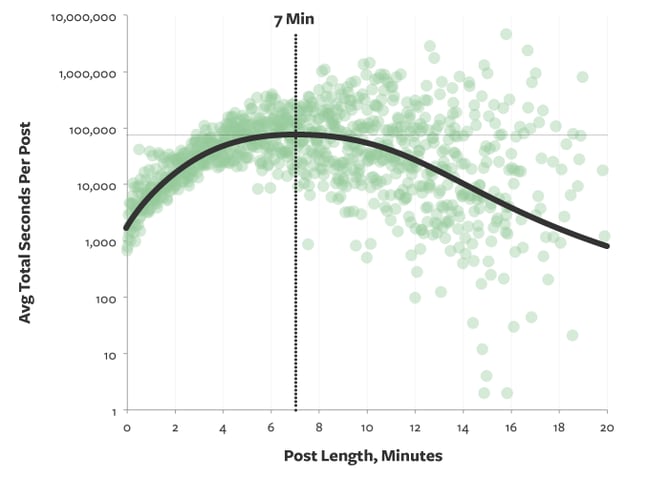 Source: Medium
Source: Medium
Quick reference:
- Post length: 2100 words
- Title: Under 60 characters
- Meta Description: Under 155 characters
Post Body
When it comes to the length of blog posts, there are a few different items to consider. For example:
- According to Medium, posts with an average read time of seven minutes captured the most attention.
- The average reading speed of native English-speaking adults remains commonly cited as 300 words per minute, according to research conducted in 1990.
- At that reading rate, the ideal post length is 2100 words.
- That aligns with research previously conducted by serpIQ, which indicated that, on average, the top 10 results for most Google searches are between 2,032 and 2,416 words.
That means that this ideal word count can address goals around both readability and SEO. But that's just the actual body of the post. Plus, when we looked at our own blog on organic traffic, we found that the sweet spot was 2,250–2,500 words.
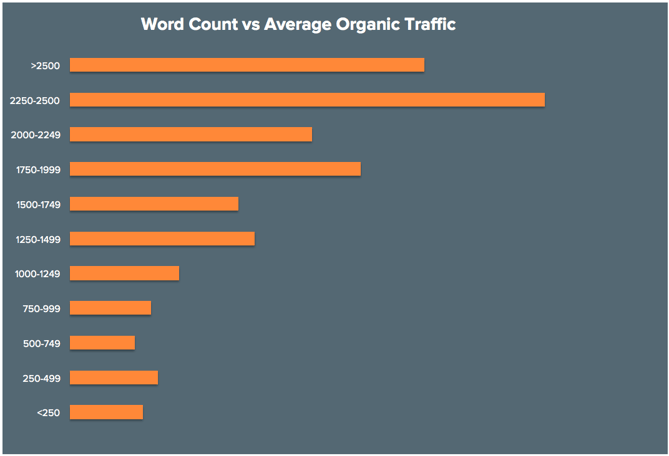
But that's just the post body -- let's have a look at the other areas of text that comprise a full blog post.
Title
The length of your title depends on your goals, and where it will appear.
Let's start with SEO. Do you want this post to rank really well in search? It turns out, that often has to do with the dimensions of each entry on a search engine results page (SERP). For Google, titles of search results are usually contained at a length of 600 pixels -- which Moz measures as being able to display the first 50-60 characters of a title tag. So, if you don't want your title to get cut off in the search results, it might be best to keep it under 60 characters. But when in doubt, you can double-check the length of your meta description and title tags with this handy tool from SEOmofo, or you can use Moz's title tag preview tool.

Then, there's optimizing your title for social sharing. On Twitter, for example, consider that each tweet has a limit of 140 characters -- however, if you include an image, that doesn't count toward the limit. But consider that even the average shortened URL takes up about 23 characters -- that leaves you with about 116 characters left for the title and any accompanying text.
In our own analysis at HubSpot, we found that headlines between 8–12 words in length got the most Twitter shares on average, while headlines with either 12 or 14 words got the most Facebook Likes.
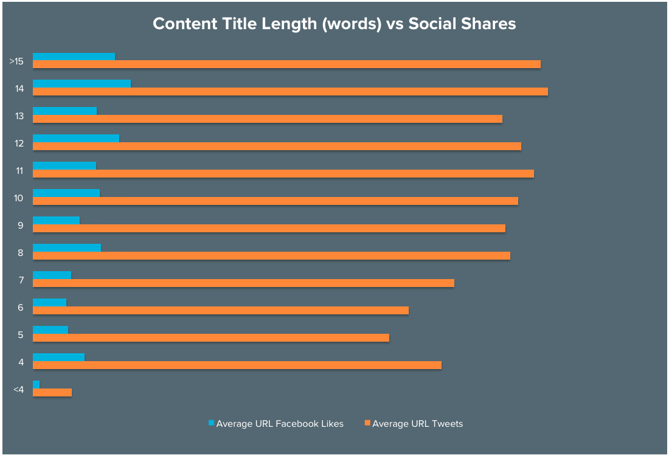
Meta Description
A meta description refers to the HTML attribute that explains the contents of a given webpage. It's the short description you see on a SERP to "preview" what the page is about.

Moz notes that Google seems to cut off most meta descriptions -- which are sometimes called snippets -- after roughly two lines of text -- though there's some conjecture that, like title tags, it's actually based on pixel count. In any case, it amounts to about 160 characters, though this particular outlet recommends keeping it at 155.
Again, you can double-check the length of your meta description and title tags with this handy tool from SEOmofo.
.gif?noresize&t=1493116440067&width=669&name=sejvREM3G7-iloveimg-compressed%20(1).gif)
2) Facebook
Quick reference:
- Status updates: 63,206-character maximum | Ideal length is 40 characters
- Video: 120-minute maximum | Ideal length is two minutes
Status Updates
Facebook's character limit on status updates is 63,206. However, that's far from ideal, says HubSpot Social Media Marketing Manager Chelsea Hunersen. "The social gurus will throw around the number 40 characters. That data seems to be backed up by BuzzSumo's ranking of HubSpot's own Facebook Page."
But why 40, specifically? "Ideally," Hunersen says, "you'll want to use the copy in a status update to provide context for whatever you're linking to." That said, she notes, the copy of the status update itself isn't as important as the copy in the meta title or meta description that gets pulled in when you insert a link into your post. That's right -- social media posts have their own meta data too.
"Often, people look at the image of the article and then directly down at the meta title and meta description for context clues," she explains. "A lot of people don't realize you can change those."
Even on Facebook, it's still best to keep your meta title to fewer than 60 characters, and to 155 for meta descriptions. There are some resources available to those familiar with coding that let you play around with social media metadata character counts, like these templates. But unless you're a developer, we recommend keeping it short and sweet.
Video
While Facebook allows a maximum of 120 minutes for videos, we wouldn't advise posting anything that long, unless you're doing a special, social-media-only screening of a full-length film.
According to research conducted by Wistia, two minutes is the "sweet spot" -- even a minute longer than that shows a significant drop in viewership. "Engagement is steady up to [two] minutes, meaning that a 90-second video will hold a viewer's attention as much as a 30-second video, the research reads," so "if you're making short videos, you don't need to stress about the difference of a few seconds. Just keep it under [two] minutes."
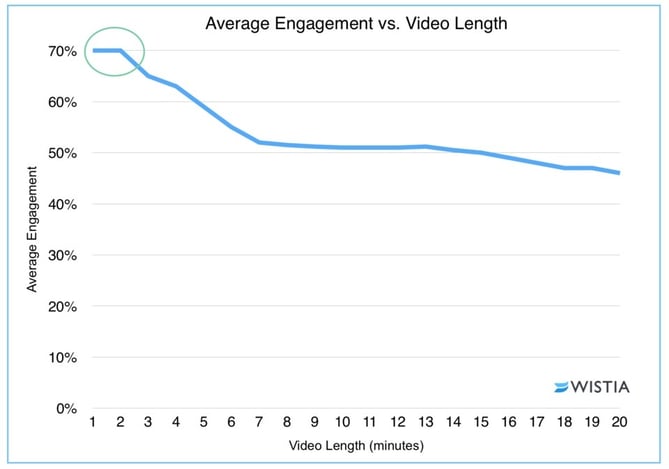 Source: Wistia
Source: Wistia
However, optimal length can vary depending on the topic. "If you produce something as catchy as BuzzFeed and Refinery29 are putting out there, it can be up to five minutes long," says Hunersen.
Regardless of the length of your video, Hunersen reminds us that all Facebook videos start without sound, meaning users have to make a conscious decision to stop scrolling through their feeds and unmute the video. Facebook videos should be visually compelling from the get-to, make sense without sound, and be engaging enough to encourage the user to stop and watch.
3) Twitter
Quick reference:
- Tweets: 140-character maximum
- Does not include images, videos, polls, or quotes tweets
- Ideal length is 120-130 characters
- Hashtags: No more than two
- Videos: Maximum length is two minutes and 20 seconds
Length of Tweets
Marketers everywhere rejoiced when Twitter finally eased up on its character count parameters, and such media as images, videos, and polls, as well as quoted tweets, ceased counting toward its 140-character limit.
Still, the "Quote Tweet" feature remains available, providing even greater character-saving measures. That happens when you press the rotating arrow icon to retweet a post, and then add a comment in the text box provided. You've still got 140 characters all to yourself to comment.
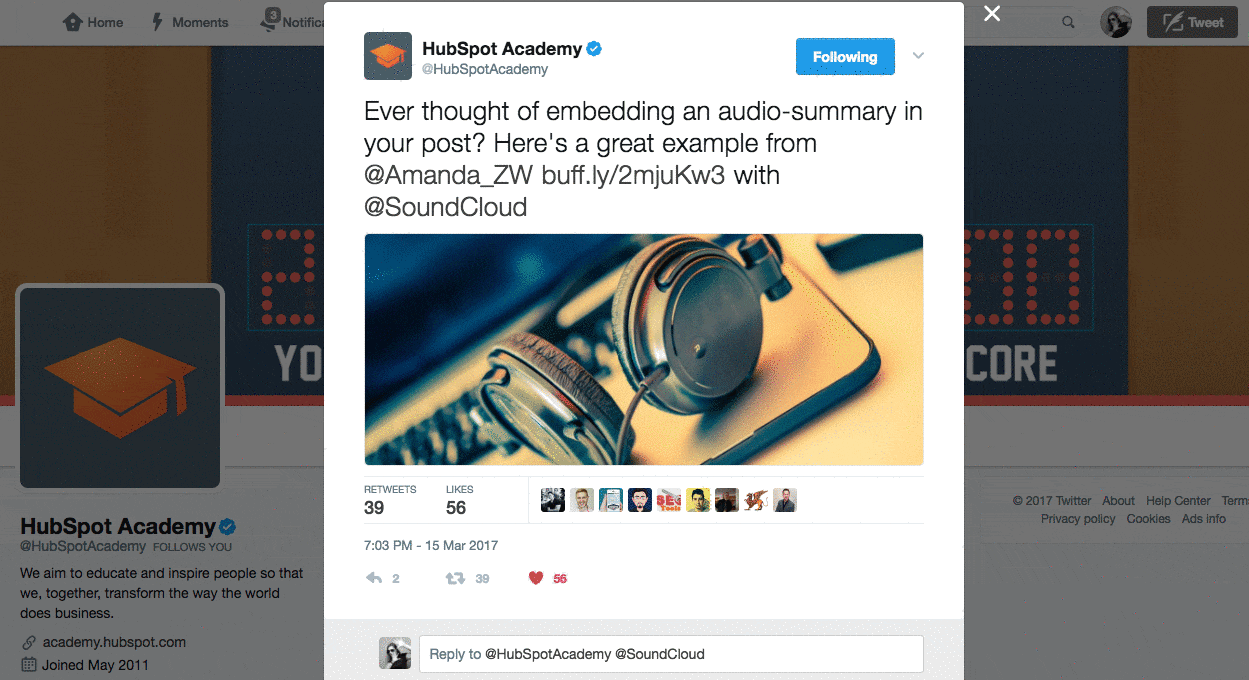
Ideal Length Overall
Like so much of what we've covered, it seems that when it comes to the overall length of a tweet, aim for short and sweet. (See what we did there?) That's resonated in research conducted by social media scientist Dan Zarrella, who found that tweets with 120-130 characters showed the highest click-through rate (CTR):
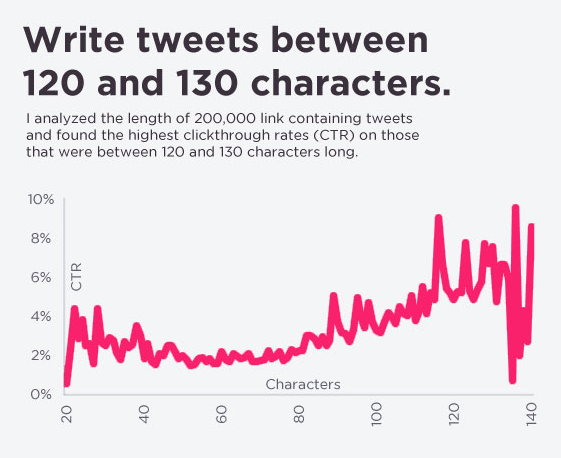 Source: Buffer
Source: Buffer
The same goes for hashtags. While they can technically be any length up to 140 characters, remember that people will want to accompany the hashtag with other copy. Short hashtags are always better. Ideally, your hashtags should be under 11 characters -- shorter if you can.
Also, in a single tweet, stick to one or two hashtags, and definitely don't go over three. Buddy Media found that all tweets with hashtags get double the engagement metrics than tweets without any. But tweets that kept the hashtags to a minimum -- one or two -- have a 21% higher engagement than tweets with three or more.
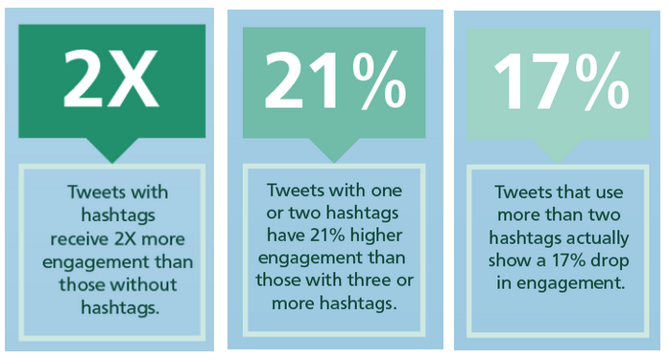 Source: Buffer
Source: Buffer
Videos
You can post a video on Twitter by importing a video or recording it using the Twitter app. In any case, the maximum video length is two minutes and 20 seconds.
4) LinkedIn
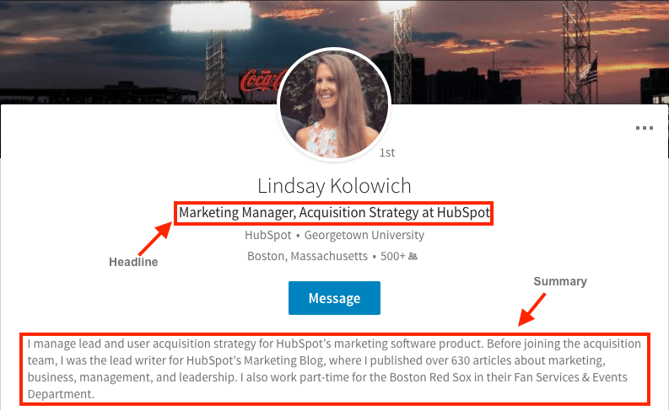
Profiles
Here's a handy list of some of LinkedIn's most important profile character maximums, according to Andy Foote:
- Professional headline: 120
- Summary: 2,000
- Position title: 100
- Position description: 2,000 (200 character minimum)
- Status Update: 600 characters -- however, Foote also notes that, "if you select to also post on Twitter from LinkedIn, only the first 140 characters will show on your Twitter post."
Original Content
With LinkedIn's publishing platform, users can now compose and share original written content with their networks, or publicly. Of course, that comes with its own character counts, according to Foote:
- Post headline: 100
- Post body: 40,000
5) Instagram
Quick reference:
- Bio: 150-character maximum
- Hashtags: Maximum of 30
- Captions: Ideal length is under 125 characters
Since Instagram is, first and foremost, a platform for sharing photos and videos, the primary focus is typically your visual content. However, it's always helpful to provide some context, and let users know what they're looking at.
Given that, here are some helpful character counts for the text you include with your visual content:
Captions
While Instagram doesn't seem to specify a maximum total number of caption characters, it does note that, within users' feeds, the caption is cut off after the first three lines. For that reason, it's advised to limit captions to 125 characters. However, don't leave out important information just for the sake of keeping your entire caption visible. Instead, frontload it with crucial details and calls-to-action, leaving any hashtags, @mentions, or extraneous information for the end.
As for Instagram Stories, there doesn't seem to be a ton of detail on character limits there, either. However, because the text overlays the visual content -- which is the focus -- don't obscure too much of the photo or video with a caption.
6) Snapchat
Quick reference:
- Character limit: 80 per post
Speaking of not obscuring visual content -- that brings us to Snapchat.
Instagram Stories was, many believe, an effort to emulate the features of Snapchat, to create an opportunity for users to share quickly-disappearing photos and videos. And again, because the focus here is on the visual, you'll want to prevent distracting viewers from it with too much text.
According to Teen Vogue, Snapchat's character limit is 80 per post, which is more than double its previous 31-character limit. And, if you're looking for more guidance, just look to this particular app's name, and remember the "snap" element of it -- a word that implies brevity -- and try not to ramble. Here's a great example of how SXSW uses its captions efficiently:
7) YouTube
Here we have yet another network that's focused on visual content, leading some to incorrectly assume that accompanying text -- like titles and descriptions -- don't matter as much.
That's not entirely false -- as a video-hosting platform, YouTube should primarily be used to showcase a brand's quality videos. However, like any other visual content, it needs context. People need to know what they're watching, who it's from, and why it matters.
Unfortunately, YouTube doesn't appear to provide any specific parameters over its character counts -- except for your channel description, which according to the official help site is limited to 1,000 characters. But other than that, it seems that the only guideline available is the alert display that lets you know, "Your [title or description] is too long," if you've entered too much text in either of those fields.
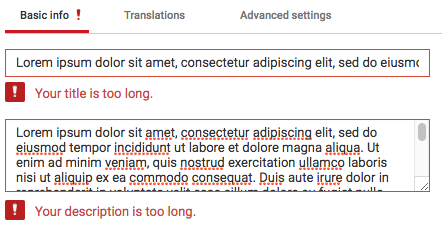
In this case, we would advise taking the same approach as adding text to support your visuals on Instagram and Snapchat. Like the former, a video's description is cut off after the first line or two, so frontload the most important descriptors and CTAs, leaving extra details for the end.
Show Your Character
As you set out to determine the length of your text, regardless of the platform, remember to do so with the user in mind. Many of these channel-mandated character limits are established for that reason -- to keep audiences from getting bored or overwhelmed.
Like anything else in marketing, however, it's never an exact science, despite the best data. We encourage you to follow these guidelines, but don't be afraid to experiment if they don't always work. Test different amounts of text within your various channels, and keep track of how each post performs. From there, you can make decisions about which types of content, as well as its accompanying titles and descriptions, are the most well-received from your audience.
How do you approach text with different online channels? Let us know in the comments.
This post was originally published in January 2016 and has been updated for accuracy and comprehensiveness.

from HubSpot Marketing Blog https://blog.hubspot.com/marketing/character-count-guide

No comments:
Post a Comment